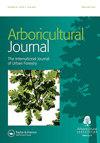How can the habitat features of ancient veteran trees be best replicated in a structural design to best utilise waste dead wood?
Q3 Agricultural and Biological Sciences
引用次数: 1
Abstract
ABSTRACT Ancient veteran trees and their associated habitat are valuable ecological cornerstones within numerous global ecosystems. However, modern pressures such as urban sprawl and rigorous safety and maintenance regimes threaten the longevity and continuity of habitat provision. Furthermore, modern Arboricultural amenity, safety and development works create large quantities of waste dead wood with limited commercial value (especially concerning wood with valuable habitat features, e.g., decay, cracks, and cavities). This study identifies the main habitat features of AVTs, the main techniques available for the utilisation of dead wood for habitat; and recommends criteria for a structural design that best utilises waste dead wood to replicate the habitat features of AVTs. The findings suggest that the structure should replicate a tubular hollow filled with detritus and decaying wood, incorporating as many cracks and cavities to access the internal structure at different horizons as possible. The final design incorporates these features, utilising as much waste dead wood as possible, in a way that best replicates valuable habitat features of an ancient veteran tree.如何在结构设计中最好地复制古树的栖息地特征,以最好地利用废弃的枯木?
古树及其相关栖息地是众多全球生态系统中宝贵的生态基石。然而,城市扩张和严格的安全和维护制度等现代压力威胁着栖息地供应的寿命和连续性。此外,现代树木美化、安全和发展工程产生了大量商业价值有限的废弃枯木(特别是具有宝贵栖息地特征的木材,例如腐烂、裂缝和空洞)。本研究确定了avt的主要栖息地特征,利用枯木作为栖息地的主要技术;并建议结构设计的标准,以最好地利用废弃的枯木来复制自动驾驶汽车的栖息地特征。研究结果表明,该结构应该复制一个充满碎屑和腐烂木材的管状空心,并结合尽可能多的裂缝和空洞,以便在不同的地平线上进入内部结构。最终的设计结合了这些特点,尽可能多地利用废弃的枯木,以一种最好的方式复制了一棵古老的老树有价值的栖息地特征。
本文章由计算机程序翻译,如有差异,请以英文原文为准。
求助全文
约1分钟内获得全文
求助全文
来源期刊

Arboricultural Journal
Agricultural and Biological Sciences-Agronomy and Crop Science
CiteScore
2.40
自引率
0.00%
发文量
28
期刊介绍:
The Arboricultural Journal is published and issued free to members* of the Arboricultural Association. It contains valuable technical, research and scientific information about all aspects of arboriculture.
 求助内容:
求助内容: 应助结果提醒方式:
应助结果提醒方式:


